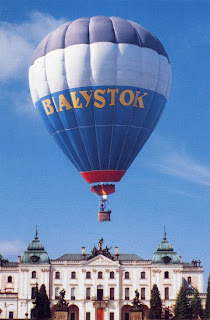 |
| The Rock Band from Hamtramck |
Immediately the mention of the Polish Muslims to younger members of Polonia invoke thoughts of a gimmicky named Hamtramck polka-rock band that play quite frequently at all types of venues because of their popularity. Although I have a couple of their music CDs and enjoy their clever songs, those are not the Polish Muslims featured here.
I’m talking about real Muslims who actually live in Poland and have successfully integrated into Polish society. The subject is as fascinating as the Haitian-Polonian article in the September LSN.
Years before the invasion of Europe by the Mongolian Hordes, Muslim traders from Asia Minor ventured into Polish territory for the purposes of commerce. A large number of Arab coins found in numerous archaeological sites throughout modern Poland backup the oral histories of such activities. But, Poland had little civil contact with Islam until the 1300’s and the advent of the first Tatar settlers.
 |
Lipka Tartars were known to
cure meat under their saddles |
Originating in the Gobi Desert and a part of the Golden Horde, Tatars had a change of heart when the horde retreated after the death of the Great Khan. The Mongol armies would never again travel so far west, but a fair number of Tatars settled in territories that eventually became the Polish-Lithuanian Commonwealth.
Being skilled warriors, Tatars who settled in Lithuania, Ruthenia and modern-day eastern Poland were allowed to preserve their Sunni religion in exchange for military service. Although most of the Tatars eventually returned to their native lands after their service expired those that stayed were encouraged to settle in the Polish-Lithuanian-Teutonic borderlands. This was noteworthy stratagem because the Lipka Tatars, as they are known, were excellent light cavalrymen and played a fairly large role in the Polish victory over the Teutonic Knights at the Battle of Grunwald in 1410.
Numerous royal privileges, as well as internal autonomy granted by the monarchs of t
he Polish-Lithuanian Commonwealth allowed the Tatars to preserve their religion, traditions and culture throughout the ages.
The most notable military clans were granted with Coats of Arms and szlachta (nobility) status, while many other families melted into the rural and burgher society. Apart from religious freedom, the Tatars were allowed to marry Polish and Ruthenian women of Catholic or Orthodox faith, which was extremely unique. Tatars were also granted representation in Parliament.
 |
| Box Office Hit in Poland |
Just for a brief time Lipka Tatars fought against the Commonwealth in the Lipka Rebellion of 1672.
The Deluge* and the ensuing period of constant wars made the nobility of central Poland associate the Muslim Lipkas with the invading forces of the Ottoman Empire.
When the massive Ottoman armies were making deep strides into Europe converting captives to their religion the Pope called on Poland to stem the tide. Despite the fact that the Lipkas initially fought for the victorious Turks, soon their camp was divided. A large contingent of Tatars dissatisfied with the Ottoman rule even though they were granted lands around the famous fortresses of Bar and Kamieniec Podolski, found the liberties enjoyed by their community within the Ottoman Empire were much less than those they experienced in the Polish-Lithuanian Commonwealth.
 |
| Fortress Bar |
In 1674, the Lipka Tatars who held the Podolia region for Turkey from the stronghold of Bar were besieged by the armies of yet to be king Jan Sobieski. A deal was struck that the Lipkas would return to the Polish side with their rights and privileges being restored.
Sobieski pardoned all the Tatars and most of them took part in his campaign against the Ottoman Turks resulting in the brilliant victory in the battle of Vienna where Polish forces were greatly out numbered.
The Lipka Rebellion forms the background to the novel
Pan Wołodyjowski, the final volume of the Nobel Prize winning historical Trilogy of Henryk Sienkiewicz. The 1969 film of Pan Wołodyjowski was one of the largest box-office successes in the history of Polish cinema.
By the 18th century most of the Tatars serving in the military had become Polonized, while the lower classes of the Muslim community gradually adopted the Ruthenian language (the predecessor of the modern Belarusian language), but in both instances the Sunni and Tatar traditions were preserved leading to the formation of a distinctive Muslim culture in Central Europe, characterized by elements of Muslim orthodoxy mixed with religious tolerance and a relatively liberal society. For instance, the women in Lipka Tartar society traditionally had the same rights as men, were granted equal status and could attend common non-segregated schools.
By 1900, Lipka Tatars become so integrated into Polish society that suffered through a century of partitions by Russia, Prussia and Austria, they joined their Roman Catholic brethren in mass migration to the United States that gave rise to American Polonia and even founded their own mosque in Brooklyn, New York, which is still in use today.
When Poland regained its independence in 1918, the Tatar community mostly inhabited the regions of Wilno (now part of Lithuania post WWII) and Białystok where wild bison still roam.
Although small, the Tatar community formed one of the most vibrant national minorities of Poland. The Muslim Religious Association focused on preserving the Muslim faith and religious beliefs while the Cultural and Educational Association of Polish Tartars worked on the preservation and strengthening of Tatar culture and traditions. Until Nazi occupation Muslim men drafted into the army were sent to the Tatar Cavalry Squadron, which was allowed to use its own uniforms and banners. In addition, the Oath for Muslim soldiers was different and sworn in presence of the Chief Imam of the Polish Army.
During and after World War II, Tatar communities of Poland suffered the same fate as the general population. Their intelligentsia was in large part murdered, as were Poles at Katyn. Then they were targeted by post-war expulsions and displacement, but a number of Tartars slipped back to the Polish side of the post-war drawn border.
Apart from the traditional Tatar communities, Poland has experienced a modest Muslim immigrant inflow. During the Communist era a number of students from socialist-aligned Arabic-speaking states in the Middle East and Africa came to Polish universities and some decided to stay.
Since the overthrow of Communism in 1989, other Muslim immigrants mostly Turks and former Yugoslavs have come to Poland. There are also smaller groups of immigrants from Pakistan, Afghanistan, and a small refugee community from Chechnya.
 |
| Polish Mosque Eastern Poland |
Mosques or prayer rooms can be found in the major cities, but the exact number of Muslims living is Poland remains unknown. The census held in 2002 did not ask for religion. An educated guess might put the number around 35,000.
While multiculturalism has always seemed to work well in Poland, a country known for tolerance even accepting Jews long ago as the rest of Europe rejected or oppressed them, things are not working out so well in neighboring Germany.
Chancellor Angela Merkel announced last month Germany's attempt to create a multicultural society has "utterly failed”, and “allowing people of different cultural backgrounds to live side by side without integrating had not worked in a country that is home to some four million Muslims.” Merkel faces pressure to take a tougher line on immigrants who don't show a willingness to adapt to German society. She said too little had been required of immigrants in the past and repeated her usual line that they should learn German in order to get by in school and have opportunities in the labor market.
A recent survey suggested more than 30% of Germans think the country is "overrun by foreigners" and that some 16 million of Germany's immigrants had come to the country for its social benefits, which now is crushing their economy.
 |
| Charles Bronson |
If you’re wondering what a Polish Lipka Tatar looks like, look no further than movie star Charles Bronson a descendant from this bloodline. It would not be so wise to look at the members of the Polish Muslim rock band mentioned at the beginning of this column.
* The Deluge was a period in the mid 17th century when rebellious outbreaks in the Ukraine territories of the Polish-Lithuanian Commonwealth so preoccupied Polish forces that Swedes invaded northern Poland where defenses were weak. But for the grace of God and the miracle at Jasna Góra, the Commonwealth could have collapsed.
A symbol of these fierce Tatar warriors is the Lajkonik - a Tatar riding a horse - and he came to play an important role in the Krakowiak, the dance of the people of Kraków. Toledo’s own Echoes of Poland Folk Dance Ensemble has a similar costume in their repertoire.
See eariler video post: Muslims Prosper in Poland












